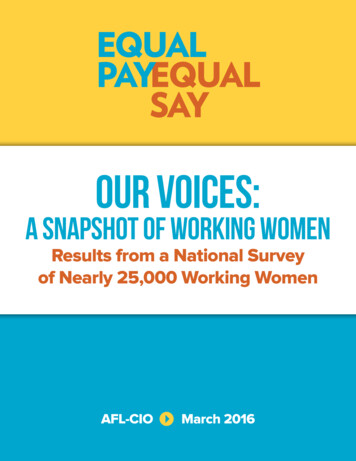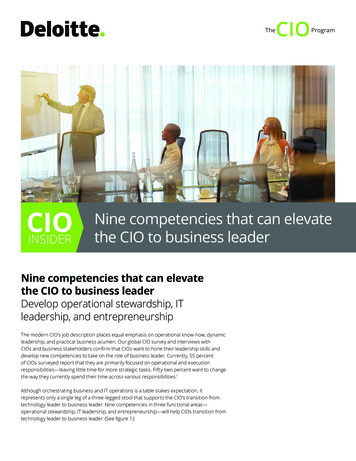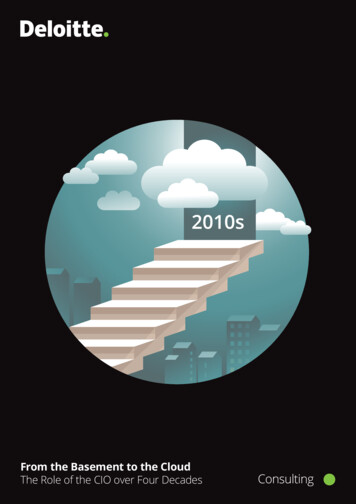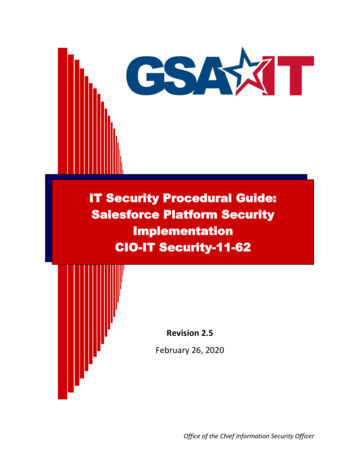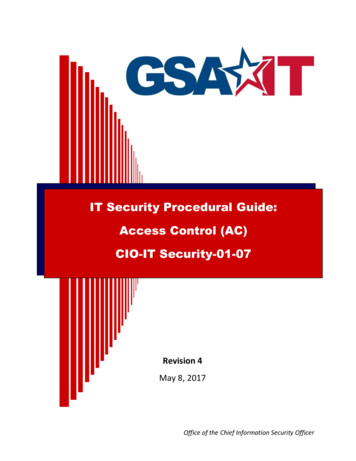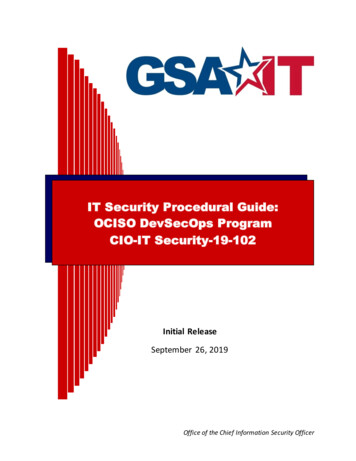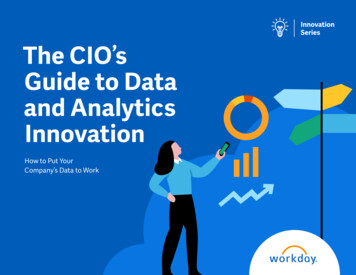
Transcription
The CIO’sGuide to Dataand AnalyticsInnovationHow to Put YourCompany’s Data to Work
Table of ContentsIntroduction03The value of having data in a single system04Connecting to outside data06Adaptable architecture enables rapid insights08Expanding on the value of a single source for data12Continuous data governance and security15Empowering HR and finance with self-service17The CIO’s Guide to Data and Analytics Innovation 2
IntroductionThe world is changing fast, and the force of changeis felt most acutely in IT. CIOs and their teams mustaccelerate digital initiatives to enable a resilientbusiness and effectively respond to challengesand opportunities stemming from unprecedentedevents, emerging geopolitical and economic factors,competitive pressures, and industry-specific dynamics.Companies are struggling to put their data to work, leaving a valuableorganizational asset largely untapped. Doubling down on analytics isimportant for moving forward and focusing on the value technologycan bring. IT teams are looking to simplify systems, reduce spend, andWorkday delivers core business systems built on a cloud architecturedesigned for change. It starts with a foundation for scalability and resiliency.We ensure maximum context for business decision-makers because weembed transactions and analytics into one system—built on a single sourceof truth, with an extensible data model enabling transactions and analysisin real time. With one source for all people and finance enterprise data,customers have the agility to plan, execute, and analyze better than everbefore. This is central to how we innovate and help our customers succeed inan ever-changing world.This guide will help CIOs understand how Workday fits in your enterprisedata strategy and how, through our trusted source for data, we can enablebusinesses to make faster, better decisions.decrease the amount of effort needed to maintain legacy systems.Ever-increasing demand from the business for actionable data andinsights means IT-centric processes are unfortunately becoming thebottleneck to organizational agility. Organizations need to make faster,more data-driven decisions while ensuring their people have the toolsand experiences they need to remain productive while remote.“Data has become critically important toorganizations in the face of external disruption,as highlighted by the COVID-19 pandemic. This isdriven by customer expectations, such as a rapidrise in e-commerce, but also by internal solutions,such as the discovery of operational efficienciesin the ‘new normal’ as a means of staying ahead ofthe competition during times of disruption.The EconomistThe CIO’s Guide to Data and Analytics Innovation 3
The value of having data in a single system.One source of truth.What does the business, and especially the C-suite, care about when it comesto data? The CIO, CFO, and CHRO should have access to the same data thatis always up-to-date, secure, and relevant within the current business context.Data should support delivered insights—in context, mapped to what’s mostimportant to business—avoiding the “needle-in-a-haystack” scenario wherethere’s too much data to determine what matters.In addition, it becomes difficult to decide which data points to rely on whendata resides in disparate source systems. Decision-makers and employeesacross all departments should use the same integrated source of truth. Atrusted data infrastructure, using a single source of truth, can: Enable fast access to data for timely decision-making Significantly decrease the time to determine which data is accurate Enhance the business intelligence (BI) of the enterprise Reach faster insightsTo stay competitive and meet a new set of customer expectations,organizations must be adaptable, with a technology foundation that’s readyfor anything. However, most organizations are running their businesseswith multiple legacy systems and silos that make it difficult to supportnew business models, introduce developing technologies, meet emergingregulatory requirements, and ensure reliability. The legacy approach of havingtransactions and analytics in separate systems is broken. With this legacyarchitecture, companies have to undertake the cumbersome process ofextracting their data and transforming it into something usable. As a result,they are basing their decisions on outdated, stale data.The CIO’s Guide to Data and Analytics Innovation 4
Workday closes the legacy gap by embedding transactions and analyticsAt Workday, we promote the value of a fit-for-purpose federated datainto one system. And because the system is based on an object-orientedstrategy. Having the data located where the transactions and analysis aretechnology, our customers can run a report, drill down into the details, andhappening ensures maximum context for business decision-makers andimmediately take action on their two most important assets—people andminimum time between decision and action.finances. Workday customers never have to worry about having outdated datafrom batch processing or multiple reporting tools for different data sourcesand report types.By keeping human capital management (HCM) and financial data at itssource, the office of the CIO—which bears ultimate responsibility for thewell-being of this data—can ensure contextual security, always-on audit, dataWe recommend keeping data as close as possible to where decisions aregovernance, and complete compliance.being made and advise that any fit-for-purpose data solution must bearchitected with security, privacy, and always-on auditability. This meanssecurity and privacy can be trusted throughout the complete data lifecycle,from creation through distribution and analysis.SecurityDistributionExperienceFinance and HR ExpertiseWhy Workday for HR, financial, and planning data?The CIO’s Guide to Data and Analytics Innovation 5
Connecting to outside data.Maximizing value.Why do organizations blend core people and finance data with external data?Workday Prism Analytics is a data hub that allows you to blend externalNew insights emerge when you combine diverse data sources, and criticaldata from any source with trusted data from Workday. This could includeinformation lies outside of the core financial and employee system of record.data from supporting financial and HR apps to industry tools, CRM,To accomplish intelligent enterprise reporting, you have to integrate or blendmarketing, service, contract labor, and subsidiaries, as well as externaldata from multiple sources. You need to standardize and enrich the data.data from governmental or other sources. Workday Prism Analytics ingestsYou need to publish that data so it is easy to consume, visualize, and analyzeand prepares high volumes of operational and historical data, giving youfor your business users. And, you need constantly available, rapid access tothe financial, HR, and operational analytics you need in one secure place.high volumes of financial, workforce, and operational data for quicker, moreWorkday provides an end-to-end single-stack data solution that providesinformed decision-making.rich data visualization, an intuitive data prep environment, high-trust accessAs many of us know, that’s not easy in a complex data architecture withvarious legacy data stores and multiple systems for operations, HCM,management, and security control with a consistent data managementexperience that is quick to set up and use.financial management, and middle-office functions. Not to mention the hugeMulti-Vendor Modelvolumes of data with inconsistent formats and varying levels of transactiondetail. Cobbling data together to uncover insights—through integrations,IT service requests, or even spreadsheets—can be time-consuming andVisualizationexhausting, if not impossible.Data day Prism Analyticsoften limited usersVisualizationlimited usersData Prepbolt-on securityGovernancedatabase layerPersistenceunpredictable costInfrastructuremultiple resources, uncertaintime frames and success ratesHigh complexity in buying, owning, and managingSupportSingle Stack, Single Security Model,Full Use, One PriceWhy Workday Prism Analytics.The CIO’s Guide to Data and Analytics Innovation 6
“Workday provides the right access to both data and insights based on ourconfigurable security model because external data is connected to the anchorobject in Workday. Workday brings the data to where the people are in theirnatural workspaces, whereas using outside tools, such as Tableau, can result infragmented insights. With Looker or Tableau, you cannot invoke the right pagesin Workday to effectively apply the insights you have. The integration of theWorkday business process flow and security model allows customers to quicklytake action on insights derived from their business, operational, and people data.Workday Prism Analytics delivers end-to-end insights in a point-and-click,configurable solution. And, of special interest to IT leaders, there is no need tohold on to legacy systems just for reporting historical data. All of that data can bebrought into Workday Prism Analytics to better understand the trends that areVice President of IT,Business Applications, Rubrikshaping a company’s future.Security Governance Reportable Insights with Drill BackExternal SystemsEnrichmentOperational DataActuals and PlansAccountingGenerationMappingError HandlingHistorical DataTransactional DataWith Workday providing secure anytime, anywhereaccess to real-time data, Rubrik plans acrossmultiple teams from finance to product operations.The quarterly reporting process has become muchmore efficient and accurate, allowing the financeteam to hold consistent QBRs and meet the CFO’sdemand for a three-day close. To automate planningin a comprehensive manner across the company issetting the foundation for growth.General LedgerSummarizedJournalsFinancial Reporting and AnalysisDataAcquisitionFrameworkDataManagementData CatalogDetailsData ivotAggregationsJoins/UnionsMetadata & WorktagsBenchmarkingLive DataOperational ime TrackingForecasts & PlansPlanningManagement ReportingMaster DataData ScienceDataPreparationWorkday ProductFinancial ManagementAccounting CenterPrism AnalyticsWorkdayTransactionsAdaptive PlanningWorkdayHow Workday complements an enterprise data strategy.The CIO’s Guide to Data and Analytics Innovation 7
Adaptable architecture enables rapid insights.The intelligent core.According to IDC, developing a future-proof, adaptable architecture is aAn adaptable technology architecture is the backbone for digital businessmust-do. As IDC authors noted in a recent report, “Effectively monetizingmodels. The intelligent core seamlessly connects back-office systems withdigital while navigating a complex, rapidly changing global environment onlyfront-office applications and dynamically adapts business processes basedbecomes possible when organizations generate an open, intelligent, andon real-time triggers and inputs. An intelligent core can ingest and analyzeextensible technology architecture.”real-time data from the ecosystem to recommend, and sometimes eventrigger, the next-best sEnterprise EngagementsPeople Assets APIIntelligentCoreExternalProcessesEcosystem EngagementsBots IoT AR/VR Connected he technology architecture for business models of the future. Source: IDC, 2020.The CIO’s Guide to Data and Analytics Innovation 8
OpenEnabling the seamless flow of dataacross the value chain to deliverreal-time interaction acrossthe ecosystemThe open and extensible architecture in Workday enables seamlessconnections among people, financial, operational, and external data. Thealternative is having to extract data out of silos, such as a data warehouse orindividual databases. Let’s examine some of the key features that power ouropen and extensible architecture:Workday Integration Cloud. This is a set of services that synchronizes data inWorkday with the many different systems used by customers. These servicesschedule and run integrations developed by Workday, Workday Partners, orcustomers in a secure, isolated, and supervised environment. The core ofIntelligentWorkday integration capabilities is a fully embedded enterprise service busTransforming structured andunstructured data coming fromtechnical standards and specifications.internal and external pipelinesinto actionable insightsWorkday also makes available APIs that work with customers’ existing(ESB) that flexibly handles the transformation of inbound and outbound datapayloads, and brokers and varies the delivery protocol to support the latestmiddleware platforms. As data is ingested into Workday, it is persisted inHadoop, and 100 percent of all data persisted is encrypted.ExtensibleProviding the capabilities to buildunique use cases that provide acompetitive advantage in industrieswhere all organizations havebest-of-breed technologyAdaptable architecture: three core attributes.The CIO’s Guide to Data and Analytics Innovation 9
Working with large volumes of operational data is simplified. With Workday,business users control how data enrichment rules are defined and configured,External Sourceswhich includes business dimensions and attributes from operational systems.ERP CRM Ops Cloud Sheets Data ScienceHCM FinancialsIngestIngestWorkday provides a single point of maintenance for business rules acrossCloudall operational activity, whether data is sourced from Workday or externalsystems. With competitors, these rules often exist in separate silos, creatingunnecessary maintenance overhead.“Workday’s architectural principles around the waydata is organized is quite powerful and unique.”BlendTransformTom McCormack,Chief Technology Officer, Western Sydney AirportPublishWorkday Prism Analytics Data SourceDiscovery BoardsCustom ReportsThe CIO’s Guide to Data and Analytics Innovation 10
Workday is architected to turn data into action. Many ERP systemsrequire analytics and reporting solutions that sit outside the systemof record, and data must be replicated from the ERP to a BI tool. WithFinancialManagement/HCM PriorityFeedsWorkday, analytics are completely integrated with the system of record,enabling real-time reporting and ad hoc analysis on live transactions.Workday provides a comprehensive set of reporting and analytics toolsExternal SourcesERP CRM Ops Cloud Sheets Data Sciencethat meet the needs of finance and accounting users, managers, andexecutives, as well as lines of business—all connected with and secured bythe same object data model, which is part of a single codeline shared withour HCM solution. Datasets can be published in-memory, with analyticsembedded in business processes or surfaced on common workspaces,such as a worker or customer profile. The security model is based on eachuser’s individual circumstances and applied to every field of every detailData Lakerecord, ensuring that in all circumstances, users only see data they areData HubEDWpermitted to see. This means that everyone can access insights in a formthat makes the most sense for their needs, but in a way that ensures theintegrity and security of the data.Enterprise AppsPOSManufacturingReporting and AnalyticsSCMThe CIO’s Guide to Data and Analytics Innovation 11
Expanding on the value of a single source for data.Distinct advantages.Analytics leaders are being asked by the business to support the growingneed for actionable insights necessary for data-driven decision-making.How can the single source of data in Workday enable faster applications ofmachine learning (ML)?The Workday data advantage.The data we possess has a distinct advantage because it comes from a singlesource and is consistently structured. Workday conducts over 8.3 billion“We couldn’t collect skills data on every singleperson at the company. Our skills and data entryfrom our employee population was about 28%. Andwith machine learning we were able to bring thatup to 73%.Kylie Riley,Workday Manager, Patagoniatransactions per month from up to 45 million users. As more customers grantWorkday permission to use their data in training our ML algorithms, we willtap into a growing volume of transactions and continue to gain more insights.Every transaction in Workday is a decision. And those decisions are essentialfuel for ML. So our system learns faster. And the faster the machine learns, thebetter the predictions it generates. Better predictions lead to better decisions.Better decisions lead to better business outcomes, for every customer.The CIO’s Guide to Data and Analytics Innovation 12
Benchmarking.Data enrichment services in Workday use a variety of data sources toenrich data. Benchmarking uses data generated from Workday customerswho have opted in to the Workday Innovation Services agreement. Some ofour other services, such as GeoTag, Gladly, and IP Lookup, are supportedwith datasets licensed from third parties.GeoTag provides geolocation services, such as mapping zip codes toaddresses. Gladly provides auto-completion and suggestions for streetaddresses all over the world. IP Lookup returns the geographic locationfrom IP addresses. All of this enables us to leverage the same foundationalbase to build a diverse but consistent set of applications—which simplyisn’t possible with siloed data sets.The CIO’s Guide to Data and Analytics Innovation 13
Workday Innovation Services.Transparency.Keeping our customers’ data security, privacy, and ownership top of mindThe ethical use of data for ML requires transparency. In the Workday context,underpins everything we do. Customers should be able to take advantageour customers know what data is being used and for what purpose. Workdayof ML without compromising privacy or trust. The Workday Innovationcustomers can make clear yes-or-no choices regarding the use of theirServices agreement governs the use of data, and customers choose to optdata, as well as finer-grained decisions around whether to allow data from ain—safeguarding privacy and trust. Our services agreement lets customersparticular country to be used. That is the ethics of data: You know where yourdecide what data they want to share with our ML algorithms by selectingdata is used and how it’s being used.which services they want to access.Workday Innovation Services are optional, cloud-native services thatextend, enhance, and improve the Workday experience. Categories includethird-party environments, such as AWS; third-party services, such asLinkedIn Learning; and intelligent apps powered by ML. Workday usesInnovation Services data only to support the Innovation Service for whichthe data is collected.GAGA Public DataEAThird-PartyEnvironmentsThird-PartyServices Content Cloud Natural WorkspacesEA Answers MomentsInnovationServicesEAGA HCM ML Journal Insights Workforce Management ML GraphIntelligentApplications Benchmarking Assistant Receipt Expense OCRThe CIO’s Guide to Data and Analytics Innovation 14
Continuous data governance and security.Integrated into the core.Good data governance ensures data is readily available, high quality, andrelevant, which enables it to create value. A truly data-driven enterpriseincludes governance as a fundamental attribute. By using one securitymodel, Workday ensures the safety of our customers’ data and that theright people have access to the right data.Because our system is born in the cloud, security is integrated into theWorkday core. This includes encrypting customer data at rest and in transit,“Given the shift in how organizations areworking, consistent and reliable flow ofdata across people, teams and businessfunctions is crucial to survival.Gartnerensuring the physical security of our servers, and embedding role-basedaccess permissions into the system. We make it easy to use multifactorauthentication and work with our customers to help them stay on top ofregulatory compliance. Audit capabilities are integrated into the fabric ofour applications, enabling Workday to have pervasive, always-on auditingfor all customer data.The CIO’s Guide to Data and Analytics Innovation 15
Security continuously applies to data regardless of how and where it’s usedor accessed. The Workday universal security model, combined with theautomated ability to audit all data updates, helps security administratorslower the time and costs associated with governance and compliance. Thisuniversal security model mitigates the risks associated with administrative“backdoor” access that might be present in legacy applications.OneConfigurableModelOur model enables us to deploy security at scale across all Workdayservices, and ensures that security improvements for one customerbenefit all customers.All execution guided by one security model Managed and auditedWith continuous security and data privacy Across complete app lifecycle Ready for evolving compliance requirements Encryption in transit and rest, fully attestedFramed with fairness and trustContinuousSecurityand PrivacyFairness andTrust Transparency in data use (ISA) Ethical AI practicesExtends to Workday Cloud PlatformThe CIO’s Guide to Data and Analytics Innovation 16
Empowering HR and finance with self-service.Controlled growth, at scale.For IT leaders, there has never been a better time to strengthen andexpand strategic partnerships with finance and HR. Having withstoodunprecedented disruptions to their businesses, priorities have certainlyshifted. McKinsey & Company has found that employees across a rangeof functions can spend around one-third of their time on non-value-addedtasks due to poor data quality and availability.Business users need to efficiently manage and transform data forconsumption. Standard requirements now include easily configurableintegrations and APIs to connect to middleware and external applications,big data preparation and processing without the need to code, and theflexibility to structure data for any type of reporting, analytics, or planninguse case. Shifting these processes out of IT and into the line of business,with an emphasis on automation, is a clear win for IT, finance, and HR. ITteams can reallocate resources toward high-value activities, such as creatingML algorithms, while finance and HR teams gain more control and scalabilityregarding critical business processes.Workday helps employees get their work done quickly and intuitively.Anticipating your HR and financial teams’ unique needs in a constantlychanging business landscape requires a flexible approach. Solving thesechallenges by extending core Workday Financial Management and WorkdayHuman Capital Management applications provides interface consistencyand removes the need to synchronize or replicate data. Our customersrapidly extend Workday data and processes to solve their unique challenges.At the core is a powerful workflow engine that makes it easy to integratethird-party workflows.The CIO’s Guide to Data and Analytics Innovation 17
The data preparation capabilities in Workday are visual and intuitive,allowing analysts to create, maintain, and adjust data transformationpipelines without the need to write code. These pipelines are explicitlydesigned to adapt to change—for example, to accommodate the additionof new data sources, adjustment of mappings, addition or removal ofdimensions and attributes—all without the months of effort commonlyrequired with legacy approaches.“What we love about Workday is that it’s not aroadblock to change, but an enabler to help usmanage change effectively.Mary Opperman,Vice President of Human Resources, Cornell UniversityThe pressure is on to turn data into action. Legacy approaches centeredon manual processes weren’t built to handle the massive amounts of databeing generated and captured by modern enterprises. Workday shifts datagovernance to the teams that are closest to the business, and businessusers control how data enrichment rules are defined and configured. WithWorkday, you reduce resources dedicated to manual processes, systemsmaintenance, and ad hoc requests from business users. This reduces ITdependence and empowers finance and HR with greater self-service.Increase ProductivityFocused on SimplicityOpen and ExtensibleFlexible to the way youwant to work.Reflects your expectationsof how applicationsshould work.Rapidly extend Workdayto support the changingbusiness.The CIO’s Guide to Data and Analytics Innovation 18
To learn more about how we can help you rapidly extendWorkday people and finance data and processes to solveunique challenges in times of extreme change, visit:workday.com/innovation1 Wallich Street, #08-02 Guoco Tower Singapore 078881Workday Singapore: 65 6800 0600 www.workday.com/en-sg 2021. Workday, Inc. All rights reserved. Workday and the Workday logo are registered trademarks of Workday, Inc.All other brand and product names are trademarks or registered trademarks of their respective ion-guide-global-ENSG
Workday Integration Cloud. This is a set of services that synchronizes data in Workday with the many different systems used by customers. These services schedule and run integrations developed by Workday, Workday Partners, or customers in a secure, isolated, and supervised environment. The core of



